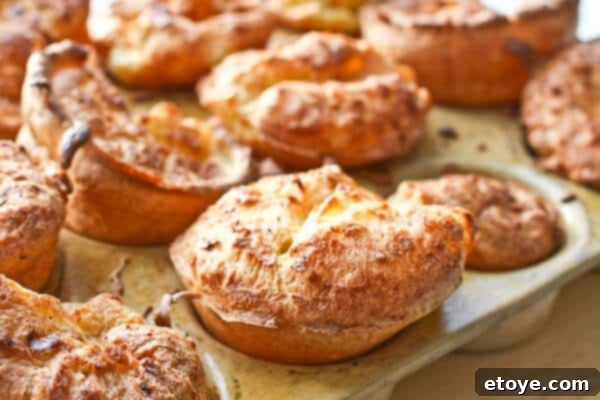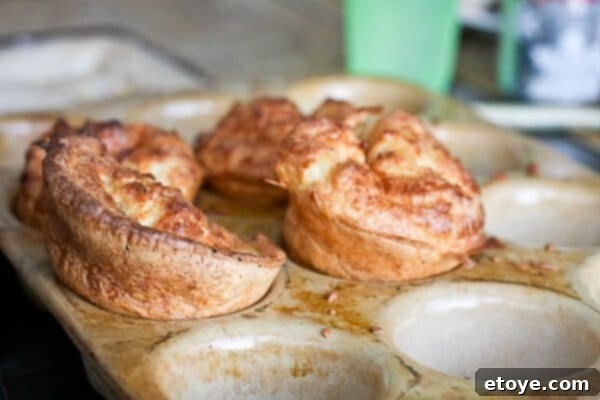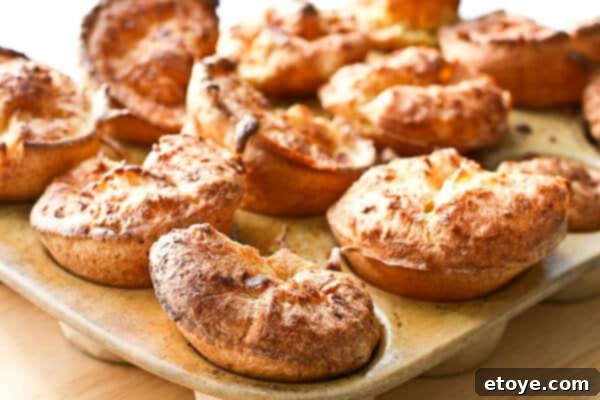No traditional roast dinner is truly complete without the golden, airy, and utterly delicious accompaniment known as Yorkshire Pudding. These iconic pastry popovers, with their signature crispy edges and soft, hollow centers, are more than just a side dish; they are a culinary cornerstone of British cuisine. This recipe promises to deliver not just good Yorkshire Puddings, but the **Best Yorkshire Puddings** you’ll ever make – consistently tall, proud, and bursting with flavor. Made with a simple, pancake-thin batter and the rich, savory essence of beef fat, these delightful breads are guaranteed to be a real crowd-pleaser at any meal, especially alongside a succulent roast. Get ready to elevate your Sunday roast with these unbelievably light and perfectly puffed wonders!

The Enduring Appeal and History of Yorkshire Puddings
Yorkshire Puddings hold a cherished place in British culinary history, originating in the northern county of Yorkshire, England. Traditionally, these savory delights were served as a first course with gravy to fill diners up, making the more expensive meat course go further. Originally known as ‘dripping puddings,’ they were cooked beneath the roasting meat to catch the flavorful fat that dripped down. This ingenious method not only utilized every last drop of precious fat but also infused the puddings with an unparalleled depth of flavor. Over centuries, they evolved into the quintessential accompaniment for roast beef, though their versatility sees them paired with various roasts and gravies today. Their simple yet profound deliciousness has cemented their status as a beloved staple, proving that sometimes, the simplest recipes yield the most extraordinary results.
Why This Yorkshire Pudding Recipe Stands Above the Rest
While many recipes for Yorkshire Puddings exist, ours is meticulously crafted to ensure consistent perfection every time. Here’s why you’ll love making and eating these:
- Effortlessly Simple: Despite their impressive appearance, these Yorkshire Puddings require only five basic ingredients and straightforward steps. You don’t need to be an expert baker to achieve fantastic results. Our clear instructions make the process fool-proof, even for beginners.
- Remarkably Light and Fluffy: The secret to a truly great Yorkshire Pudding lies in its dramatic rise and airy texture. This recipe consistently delivers puddings that puff up beautifully, creating that signature hollow, cloud-like interior that’s perfect for soaking up gravy.
- The Ultimate Roast Companion: Whether you’re serving a grand beef roast, a tender pork loin, or even a flavorful lamb leg, these puddings are the ideal savory side. Their ability to complement rich meats and sauces makes them an indispensable part of any celebratory meal.
- Incredible Flavor Infusion: By utilizing the rendered fat directly from your roast beef or pork, we elevate the flavor profile of these puddings to an extraordinary level. This traditional method ensures a deeply savory taste and a wonderfully crisp texture that cannot be replicated with plain oil. The beef fat creates an irresistibly golden-brown crust and contributes to their magnificent rise and structure.
- Consistently Tall and Proud: Forget deflated, disappointing puddings. Our method focuses on key techniques that guarantee your Yorkshire Puddings will stand tall and proud, maintaining their impressive height from oven to table. You’ll be amazed at their structural integrity and visual appeal.
Essential Ingredients for Perfect Yorkshire Puddings
Achieving outstanding Yorkshire Puddings starts with understanding the role of each simple ingredient. Using them correctly is key to their success.
- 3 Large Eggs: Ensure your eggs are at room temperature. This helps them emulsify better with the milk, creating a smoother batter and contributing to a better rise.
- 1 1/2 Cups Milk: Like the eggs, room temperature milk is crucial. Cold milk can inhibit the gluten development and impact the final texture of the pudding.
- 3/4 Teaspoon Table Salt (or 1 1/2 teaspoons Kosher Salt): Salt enhances the flavor of the batter. The measurement difference accounts for the varying crystal sizes of table versus kosher salt.
- 1 1/2 Cups Unbleached All-Purpose Flour (approximately 7 1/2 ounces, sifted): Sifting the flour is vital. It removes lumps, aerates the flour, and ensures a smooth batter that rises uniformly. Unbleached flour often has slightly more protein, which can benefit gluten development and structure.
- 3 Tablespoons Beef Fat (from your roast): This is the secret ingredient for authentic flavor and incredible crispness. The high smoke point and rich savory taste of beef fat are irreplaceable. If you don’t have beef fat, see our “Vegetarian Alternatives” section for suitable substitutes, though beef fat remains the gold standard for traditional Yorkshire Puddings.

Crafting the Best Yorkshire Puddings: A Step-by-Step Guide
Follow these precise instructions to create Yorkshire Puddings that will be the highlight of your meal. Attention to detail, especially regarding temperature, is key!
The Best Yorkshire Puddings (Recipe)

Author: Jaden Hair
Rating: 5 out of 5 stars (from 1 vote)
Prep Time: 5 mins
Cook Time: 30 mins
Total Time: 35 mins
Course: Side Dish
Cuisine: American, British
Servings: 6 servings (12 large muffin sized Yorkshire Puddings)
Calories: 183 kcal
Ingredients
- 3 large eggs (at room temperature)
- 1 1/2 cups milk (at room temperature)
- 3/4 teaspoon table salt (or 1 1/2 teaspoons kosher salt)
- 1 1/2 cups unbleached all-purpose flour (7 1/2 ounces, sifted)
- 3 tablespoons beef fat (from your roast)
Instructions
- Prepare the Batter: In a large bowl, whisk together the room temperature eggs, milk, and salt until well combined and frothy. Gradually sift in the flour in three stages, whisking thoroughly after each addition until no lumps of flour remain. This ensures a smooth batter and incorporates air. Avoid over-whisking once the flour is added. Let the batter rest at room temperature for at least 30 minutes, and up to 3 hours. This resting period allows the gluten to relax and the starch to hydrate, which is crucial for achieving a light, airy texture and a superior rise.
- Preheat Oven and Prepare Fat: Once your prime rib roast (or other roast) is finished cooking and you have rendered fat available, carefully spoon out 3 tablespoons of this rich beef fat. Preheat your oven to a high temperature of 450°F (230°C). This high initial temperature is vital for the puddings to puff up dramatically.
- Enhance the Batter: Stir 1 tablespoon of the rendered beef fat into your prepared Yorkshire pudding batter. This step adds an extra layer of savory flavor and contributes to a beautiful golden crust.
- Heat the Pan to Smoking Point: Place a 12-cup muffin pan (or a traditional popover pan) into the preheated oven. Add 1/2 teaspoon of the remaining beef fat into each cup of the muffin pan. Heat the pan in the oven for about 3 minutes, or until the fat is visibly smoking hot. This extreme heat is the single most important factor for achieving that spectacular puff.
- Pour and Bake – The Critical Phase: Carefully remove the intensely hot muffin pan from the oven (using sturdy oven mitts is essential!). Immediately and quickly pour the rested batter into each hot cup, filling them approximately two-thirds full. Work swiftly to maintain the pan’s heat. Return the pan to the oven without delay and bake for 20 minutes. It is critically important **not to open the oven door** during this initial baking phase. The sudden drop in temperature will cause your Yorkshire puddings to collapse, preventing them from achieving their characteristic height and crispness.
- Finish Baking for Golden Perfection: After 20 minutes, reduce the oven temperature to 350°F (175°C) and continue baking for an additional 10 minutes, or until the Yorkshire puddings are beautifully golden brown, crisp, and fully set.
- Release Steam and Serve: Once baked, remove the puddings from the oven. To prevent them from collapsing as they cool, gently pierce each Yorkshire pudding with a toothpick or a small, sharp knife to release the trapped steam from inside. Serve immediately with your roast dinner and plenty of rich gravy for an unforgettable culinary experience.
Notes
This exceptional Yorkshire Pudding recipe is inspired by the culinary experts at Cook’s Illustrated, renowned for their precise and scientific approach to cooking. For an extra indulgent twist (but don’t tell anyone!), I’ve even made these with bacon drippings when a prime rib wasn’t on the menu. The result was absolutely delicious, offering a slightly different but equally delightful savory note!
Nutrition (per serving)
- Calories: 183 kcal
- Carbohydrates: 27g
- Protein: 8g
- Fat: 4g
- Saturated Fat: 2g
- Cholesterol: 88mg
- Sodium: 362mg
- Potassium: 159mg
- Fiber: 1g
- Sugar: 3g
- Vitamin A: 218 IU
- Calcium: 86mg
- Iron: 2mg
Keyword: popovers, savory muffins, yorkshire puddings, traditional british recipe, roast dinner accompaniment


Mastering Yorkshire Puddings: Expert Tips for Success
While the recipe instructions are thorough, these additional tips will help you consistently achieve the best possible Yorkshire Puddings:
- Room Temperature Ingredients Are a Must: As mentioned, ensure your eggs and milk are at room temperature. This helps the batter come together smoothly and promotes a better, more even rise in the oven. Cold ingredients can shock the hot fat and lead to less impressive puddings.
- Sift Your Flour Diligently: Don’t skip this step. Sifting aerates the flour, prevents lumps, and ensures a light batter. It also helps the flour combine more easily with the wet ingredients, creating a uniform consistency that is crucial for proper puffing.
- Don’t Skimp on Resting Time: The 30 minutes to 3 hours of resting time for the batter is not optional. It allows the gluten to relax, resulting in a more tender pudding, and gives the flour time to fully hydrate, which contributes to the characteristic airy texture and impressive height.
- The Fat Must Be Smoking Hot: This is arguably the most critical step. The batter needs to hit extremely hot fat to create that instant, explosive puff. If the fat isn’t hot enough, your puddings will be flat and dense. Watch for wisps of smoke – that’s your cue!
- The “No Peek” Rule: Resist the urge to open the oven door during the initial baking phase. Fluctuations in temperature will cause your Yorkshire Puddings to deflate and collapse. Trust the process and your oven.
- Pierce After Baking: Once out of the oven, quickly pierce each pudding with a toothpick. This allows steam to escape, preventing the interior from becoming soggy and helping the puddings hold their shape as they cool slightly.
- The Right Fat Makes All the Difference: For authentic flavor and crispness, rendered beef fat is unmatched. If not available, fats with a high smoke point like lard, goose fat, or high-quality vegetable shortening can be used, but the depth of flavor will differ.
- Muffin Tin vs. Popover Pan: While a dedicated popover pan with deep, narrow wells is excellent, a standard muffin tin works perfectly well for this recipe. Just ensure your cups are well-greased and the fat is smoking hot.
- Don’t Overfill the Cups: Filling each cup about two-thirds full allows enough space for the puddings to rise dramatically without overflowing. Too much batter can hinder their ability to puff up effectively.
- Oven Temperature Calibration: If you suspect your oven runs hot or cold, consider using an oven thermometer to ensure the precise temperatures required for these puddings.
Troubleshooting Common Yorkshire Pudding Problems
Even with the best recipe, challenges can arise. Here’s how to tackle common issues:
- My Yorkshire Puddings didn’t rise!
- **Issue:** Cold ingredients. **Solution:** Always use room temperature eggs and milk.
- **Issue:** Fat wasn’t hot enough. **Solution:** Ensure the fat is smoking hot before adding the batter. Don’t rush this step.
- **Issue:** Oven door opened during baking. **Solution:** Resist the urge to check on them! Any temperature drop can cause them to collapse.
- **Issue:** Batter not rested. **Solution:** Allow at least 30 minutes for the batter to rest, ideally longer.
- My Yorkshire Puddings collapsed after taking them out of the oven!
- **Issue:** Steam trapped inside. **Solution:** Immediately pierce each pudding with a toothpick or small knife to release steam once they come out of the oven.
- **Issue:** Not fully cooked. **Solution:** Ensure they are golden brown and firm, not just risen. Sometimes they need a few extra minutes at the lower temperature.
- My Yorkshire Puddings have soggy bottoms!
- **Issue:** Fat wasn’t hot enough. **Solution:** Reiterating, the fat needs to be smoking hot to create a crispy base.
- **Issue:** Too much batter. **Solution:** Only fill the cups two-thirds full. Overfilling can lead to a dense, soggy bottom.
- **Issue:** Not enough fat. **Solution:** Ensure there’s a good film of fat in each cup, about ½ teaspoon.
Make Ahead & Storage Solutions for Your Convenience
Yorkshire Puddings are best served fresh and hot, but they can certainly be prepared in advance to ease your meal planning.
- Batter Preparation: The batter can be made up to 2 hours ahead of time and kept at room temperature. If you need to make it further in advance, store it in the refrigerator for up to 24 hours, but be sure to bring it back to room temperature for at least 30-60 minutes before baking for the best results.
- Cooking Ahead: Cooked Yorkshire Puddings can be made completely ahead of time. Allow them to cool fully, then store them in an airtight container at room temperature for up to 2 days, or in the refrigerator for up to 4 days.
- Freezing: These puddings freeze exceptionally well! Once cooled completely, place them in a single layer on a baking sheet and freeze until solid. Then, transfer them to a freezer-safe bag or airtight container, where they will keep for up to one month. This is perfect for batch cooking and having a stash ready for future roasts.
- Reheating: To reheat, simply place the puddings on a baking sheet in a hot oven (around 375°F / 190°C) for about 8-10 minutes for refrigerated puddings, or 10-15 minutes for frozen ones, until they are hot, crisp, and re-puffed.
Vegetarian Alternatives and Other Delicious Variations
While traditional Yorkshire Puddings shine with beef fat, there are fantastic alternatives and variations to explore.
- Vegetarian Option: For those avoiding animal fats, choose a fat with a high smoke point. Excellent choices include sunflower oil, vegetable oil, or a solid vegetable shortening like Crisco or Trex. These will still give you a great rise and crisp texture, though the flavor profile will be slightly different from the beef-fat version. Lard is another excellent option for non-vegetarian, non-beef fat users, offering a wonderful crispness and neutral flavor.
- Herb-Infused Puddings: For an aromatic twist, try adding a pinch of finely chopped fresh rosemary or thyme to your batter. These herbs complement roast meats beautifully.
- Garlic & Onion Powder: A small amount of garlic powder or onion powder can deepen the savory profile of your puddings, especially if you’re using a neutral oil.
- Cheesy Puffs (Gougeres): If you’re looking for a similar concept but with a cheesy twist, consider making Gougeres. These savory cheese puffs are made from a basic Pâte à Choux batter. Simply prepare a standard Pâte à Choux and fold in a generous amount of shredded Gruyère or cheddar cheese before baking. They are incredibly simple to make and offer a delightful, cheesy alternative, perfect if you’re not in the mood for traditional Yorkshire Puddings but still want a light, savory baked good for dinner.
Serving Suggestions for Your Perfect Yorkshire Puddings
While synonymous with roast beef, Yorkshire Puddings are incredibly versatile. Here are a few ways to enjoy them:
- Classic Roast Dinner: The ultimate pairing is, of course, with a succulent roast beef, rich gravy, roasted potatoes, and seasonal vegetables.
- Beyond Beef: Don’t limit yourself! They are fantastic with roast pork, lamb, chicken, or even a hearty beef stew. The crisp walls are perfect for scooping up thick sauces.
- Breakfast/Brunch: Yes, really! Fill smaller Yorkshire puddings with scrambled eggs, bacon, and a drizzle of maple syrup for a savory-sweet breakfast treat.
- Mini Appetizers: Bake them in mini muffin tins and fill them with cream cheese and chives, smoked salmon, or a dollop of cranberry sauce for elegant party appetizers.
- Sweet Treat: Though traditionally savory, some enjoy them with a sprinkle of sugar and a drizzle of golden syrup or jam for a rustic dessert.
More Culinary Inspirations
If you’ve mastered these Yorkshire Puddings, perhaps you’re ready to explore other classic roast dinner components and side dishes:
- Perfect Prime Rib Roast Recipe with Red Wine Jus
- 1-Step, Fail Proof Prime Rib Recipe on the Rotisserie
- Roasted Garlic Mashed Potatoes Recipe
- Ruth’s Chris Sweet Potato Casserole Recipe
Making the Best Yorkshire Puddings doesn’t have to be intimidating. By following this detailed guide and embracing a few key techniques, you’ll be consistently turning out impressively risen, golden, and incredibly delicious popovers. They are the perfect complement to any roast, transforming a simple meal into a memorable feast. Don’t hesitate – give this recipe a try and prepare to amaze yourself and your dinner guests!
This Yorkshire Pudding recipe is proudly brought to you, with inspiration from the meticulous culinary science of Cook’s Illustrated. The secret to these amazing puffs is truly in following the directions precisely! Enjoy your baking!
